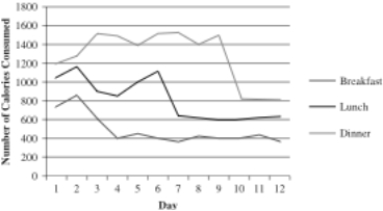Multiple Choice
Dr. Anderson is a nutritionist who helps clients lose weight prior to surgery. She is working with W. J., a male client who is planning on undergoing a heart transplant. He currently eats more than 3,500 calories a day and has been asked by his doctor to cut the number of calories to about 1,800 (400 for breakfast, 600 for lunch, and 800 for dinner) . She is curious as to whether a food journal will help W. J. reduce the number of calories he eats. A food journal is used to record everything a person eats to help patients be more aware of what they're eating. W. J.'s wife also recorded the food he consumed at each meal to have complete data before introducing the journal. Dr. Anderson decides to phase in the food journal gradually, initially only having W. J. record what he ate at breakfast during the first three days after baseline (days 4-6) . During days 7-9, the journal is used at lunch, too, and during days 10-12, it also is used during dinner. The data for Dr. Anderson's study are below.
If Dr. Anderson wanted to change the study to a stable-baseline design, which of the following would she change?
A) The time she introduces the intervention
B) The dependent variable
C) The type of intervention
D) How frequently she measures the dependent variable
Correct Answer:

Verified
Correct Answer:
Verified
Q1: A small-N design that involves providing treatment
Q2: Dr. Fletcher is interested in whether joining
Q3: Which of the following is an independent-groups
Q4: Which of the following is true of
Q6: Dr. Fletcher is interested in whether joining
Q7: A wait-list design is helpful in dealing
Q8: Which of the following CANNOT typically be
Q9: Dr. Anderson is a nutritionist who helps
Q10: Which of the following people would be
Q11: Dr. LaGuardia is a cognitive neuroscientist who